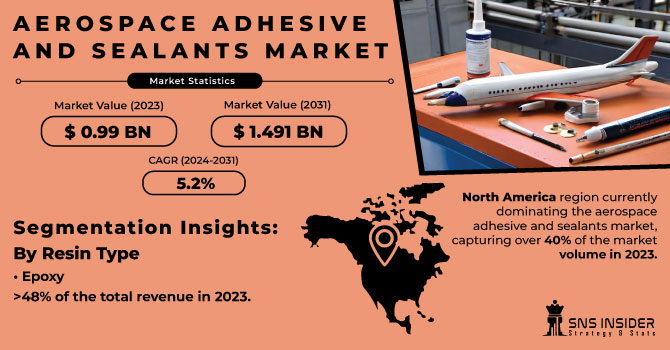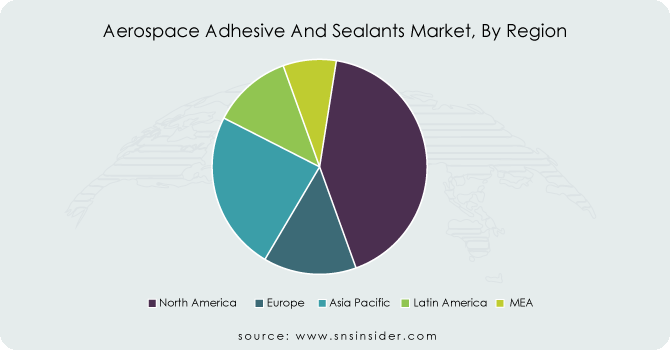Aerospace Adhesives & Sealants Market Report Scope & Overview:

Get More Information on Aerospace Adhesive And Sealants Market - Request Sample Report
The Aerospace Adhesives & Sealants Market was USD 1.1 billion in 2023 and is expected to reach USD 1.7 billion by 2032, growing at a CAGR of 5.1% over the forecast period of 2024-2032.
The increased demand for lightweight materials in the aerospace industry is a key driver for the growing use of advanced adhesives and sealants. As the aerospace sector continues to prioritize fuel efficiency and sustainability, reducing the weight of aircraft has become a critical objective. For example, agents such as composites and aluminum alloys are more typically used in the structure of the aircraft to minimize overall weight and after that, this figure is really the biggest significant input toward a fuel and carbon-efficient jet. In this context, adhesives and sealants are the key enabling materials that not only provide the requisite bond and seal, but they also ensure that these solutions meet the demanding requirements of durability without a significant increase in weight. While aerospace applications need strength and durability, they must also be lightweight to enhance performance and efficiency, hence the use of such advanced materials. The continued demand for lightweight materials, and the adhesive and sealants that support them, will provide high growth opportunities as manufacturers seek to achieve greater fuel efficiency and meet strict environmental requirements, further fueling innovation and adoption in the aerospace industry.
In 2024, H.B. Fuller acquired H.S. Butyl Limited, of premium butyl tapes, enhancing its position in the specialty construction tapes market.
The rising output of commercial jets is largely driven by the increasing global need for passenger and cargo flights. With air travel growing in a catch over the years, as economies develop and disposable earnings belongings are on the rise, international passenger visitors are anticipated to grow at a strong charge in the future. According to the International Civil Aviation Organization (ICAO), the total number of passengers carried on scheduled services increased to 3.3 billion in 2022, a rise from the previous year. This demand has led airlines to expand and modernize their fleets, which in turn has sent aircraft manufacturers increasing output. In this process, adhesives and sealants are the key products, and these are also used for fastening & sealing major designs including fuselages, wings, and interiors. Such materials play an important role in maintaining structural integrity while reducing weight and maximizing fuel efficiency both crucial elements in contemporary air travel. Moreover, the demand for high-performance adhesives and sealants is expected to be stronger due to a strong backlog of orders from major manufacturers such as Boeing and Airbus, thereby providing a positive outlook for the aerospace industry.
Aerospace Adhesives & Sealants Market Dynamics
Drivers
-
The rising adoption of drones drives the aerospace adhesives and sealants market.
The increasing use of drones is one of the major factors boosting the aerospace adhesives & sealants market growth since these unmanned aerial vehicles (UAVs) are gaining popularity in both military and commercial application areas. Drones are applicable in diverse industries, including delivery, surveillance, agriculture, environmental monitoring, and many spinoff markets, filling the need for lightweight, robust, and low-energy materials. Drone composite materials and structures; Adhesives, and sealants are essential in bonding, aerodynamic performance, structural integrity, and long-term durability. They assist in saving weight while being resistant to moisture, dust, and temperature. With the ever-evolving drone technology and integration of drones into the daily system, the adequately specialized types of adhesives and sealants have artificially challenged innovative achievement and market growth for these systems.
This expansion is attributed to the growing adoption of drones in commercial applications such as delivery services, surveillance, and agriculture. For instance, China has recently trialed its largest cargo drone, aiming to develop its low-altitude economy, which is projected to become a 2 trillion-yuan industry by 2030.
Restraint
-
Volatile raw material prices may hamper the market growth.
The growth of the aerospace adhesives and sealants market is restrained by fluctuating prices for raw materials. Adhesives & sealants are manufactured using raw materials like resins, chemicals, & polymers, and since, they are key components of their production, the prices of these raw materials fluctuate based on supply chain distortions, geopolitics, & consumption changes. Such price variations can increase costs of production at the manufacturer's end making it tough to keep a constant price for the end consumers. Due to their significant contribution to operational budgets and profit margins, higher material costs could have ramifications for aerospace companies, where precision and quality are highly demanded. Furthermore, uncertain raw material prices can stymie the manufacturers from planning and scaling the production process, resulting in product delivery delays or possible price increases. Consequently, the aerospace adhesives and sealants market may struggle to maintain market growth, as well as provide the advanced adhesive technologies that have started to gain traction.
Aerospace Adhesives & Sealants Market Segmentation
By Resin Type
Epoxy held the largest market share around 48% in 2023. This dominance stems from their exceptional properties, making them the perfect fit for demanding aerospace applications. Large wing skins, composite ribs, sandwich panels, and other carbon composite substrates all rely heavily on epoxy adhesives for secure bonding. epoxies offer a winning combination of physical characteristics. They boast a high coefficient of thermal expansion, meaning they can withstand temperature fluctuations without compromising the bond. Their impressive compressive strength ensures they can handle significant loads without crushing. Low elongation to fracture translates to minimal stretching or breaking when under stress, crucial for maintaining structural integrity in aircraft.
By Technology
The solvent borne segment held the largest market share around 44% in 2023. This is mainly attributed to their excellent bonding properties, versatility, and compatibility with several substrates (such as metals, plastics, and composites), which are widely used in aerospace applications. Meanwhile, high-performance properties such as excellent heat resistance, flexibility, and durability can give NEA's characteristics of soluble adhesives are suitable for application in the aircraft field (aircraft interior, exterior panels, and structure) in strong environment. While the trend is gradually moving towards the usage of water-borne and other eco-friendly adhesives (because of the stringent norms regarding the sustainable limits on volatile organic compounds (VOCs)), solvent-borne adhesives continue to have a dominant share in the aerospace coating adhesives and sealants market on account of their established track record and ability to fulfil stringent demand in the aerospace industry.
By End User
Commercial held the largest market share around 65% in 2023. This can be attributed to the large demand for aircraft in the growing commercial aviation industry. The increasing inflow of air passengers and cargo airlines is leading to the expansion of fleet size, which is supporting market growth, as aircraft assembly, maintenance and repairs require high-performance adhesives and sealants. These are essential components to ensure strength and safety of aircraft by providing strong bonding, sealing from moisture and air pressure, and increasing fuel efficiency. The growth of the commercial aviation industry, especially in developing nations, continues to drive this desire for high performance materials. Moreover, with a greater emphasis on lowering operating costs and enhancing durability from commercial airlines, the need for high-performance, durable adhesive and sealant technology solutions is imperative.
Aerospace Adhesives & Sealants Market Regional Analysis
North America region dominated the aerospace adhesive and sealants market, capturing over 40% of the market volume in 2023. This leadership stems largely from the US government's unwavering focus on strengthening its military forces. Increased defense spending translates to significant opportunities for contractors and their supply chains, driving demand for advanced adhesives and sealants used in modern military aircraft. This trend is expected to continue well into the future, ensuring North America remains a key player. Additionally, the increase in air travel in the region and the growing commercial aircraft fleet are also aiding the market growth. Moreover, lightweight characteristics coupled with fuel efficiency, as well as the growing adoption of composite materials tourism aviation applications are further fueling the North America aerospace adhesives and sealants market growth. Lastly, government expenditure on defense and aerospace programs in the U.S. also fuels the demand for aerospace components and materials, such as adhesives and sealants, and further strengthens the domination of the region in terms of market share.

Get Customized Report as per Your Business Requirement - Request For Customized Report
Key Players
- Henkel AG & Co. KGaA (Loctite EA 9396, Loctite 7705)
- 3M (Scotch-Weld DP 460, Scotch-Weld DP 8405NS)
- PPG Industries Inc. (PPG PR-1422, PPG PR-1776)
- Huntsman International LLC. (Araldite 2011, Araldite 2021)
- Solvay Group (Cytec 5275-1, Cytec 9235)
- Master Bond Inc. (EP42HT-2, EP21AOHT)
- Beacon Adhesives (Beacon 1007, Beacon 1211)
- DuPont (Betamate 2090, Betaforce 2070)
- H.B. Fuller Company (Fuller OX-700, Fuller 2062)
- Scigrip Adhesives (SG-500, SG-700)
- Illinois Tool Works Inc. (ITW Devcon 10360, ITW Devcon 12540)
- LORD Corporation (Lord 400, Lord 302)
- Arkema (Kraton D1102, Kynar PVDF)
- Permabond (Aero 933, A1011)
- Sika AG (Sikaflex-295 UV, Sikaflex-552)
- ITW (Devcon 12450, Devcon 13380)
- Bostik (Bostik 1130, Bostik 2121)
- Royal Adhesives & Sealants (RC-1299, RC-2001)
- Dupont (Betaseal 1745, Betaforce 1080)
- Momentive (Silopren LSR 7000, RTV 118)
Recent Development:
- In August 2023: PPG Industries is ramping up its presence with a USD 9.8 million investment to expand their adhesives and sealants product line at their Temple, Texas facility.
- In October 2023: Solvay is adding fuel to the fire with the introduction of FusePly 250, their latest innovation in chemical bonding technology designed for high-temperature applications (250°F and above) in aerospace manufacturing. This complements their existing FusePly 100.
| Report Attributes | Details |
|---|---|
| Market Size in 2023 | US$ 1.1 Billion |
| Market Size by 2032 | US$ 1.7 Billion |
| CAGR | CAGR of 5.1% From 2024 to 2032 |
| Base Year | 2023 |
| Forecast Period | 2024-2032 |
| Historical Data | 2020-2022 |
| Report Scope & Coverage | Market Size, Segments Analysis, Competitive Landscape, Regional Analysis, DROC & SWOT Analysis, Forecast Outlook |
| Key Segments | • By Resin Type (Epoxy, Silicone, Polyurethane, Others) • By Technology (Solvent borne, Water borne, Others) • By User Type (Original Equipment Manufacturer, Maintenance Repair and Operations) • By End User (Commercial, Military, General Aviation) |
| Regional Analysis/Coverage | North America (US, Canada, Mexico), Europe (Eastern Europe [Poland, Romania, Hungary, Turkey, Rest of Eastern Europe] Western Europe] Germany, France, UK, Italy, Spain, Netherlands, Switzerland, Austria, Rest of Western Europe]), Asia Pacific (China, India, Japan, South Korea, Vietnam, Singapore, Australia, Rest of Asia Pacific), Middle East & Africa (Middle East [UAE, Egypt, Saudi Arabia, Qatar, Rest of Middle East], Africa [Nigeria, South Africa, Rest of Africa], Latin America (Brazil, Argentina, Colombia, Rest of Latin America) |
| Company Profiles | Henkel AG & Co. KGaA, 3M, PPG Industries Inc., Huntsman International LLC., Solvay Group, Master Bond Inc., Beacon Adhesives, DuPont, B. Fuller Company, Scigrip Adhesives, Illinois Tool Works Inc., LORD Corporation, Arkema, Permabond, Sika AG, ITW, Bostik, Royal Adhesives & Sealants, Dupont, Momentive, and Others |
| Key Drivers | • The rising adoption of drones drives the aerospace adhesives and sealants market. |
| Restraints | • Volatile raw material prices may hamper the market growth. |

